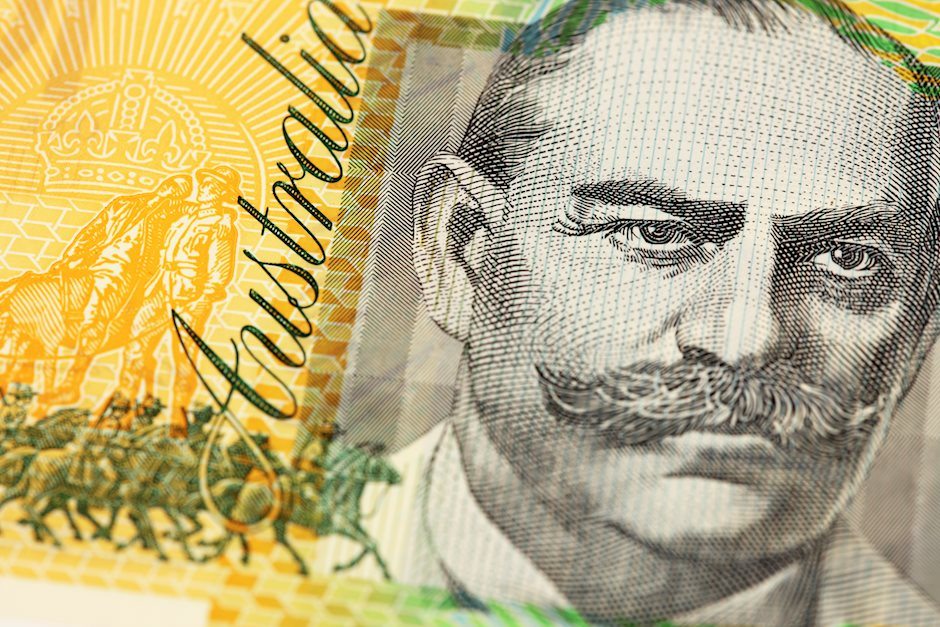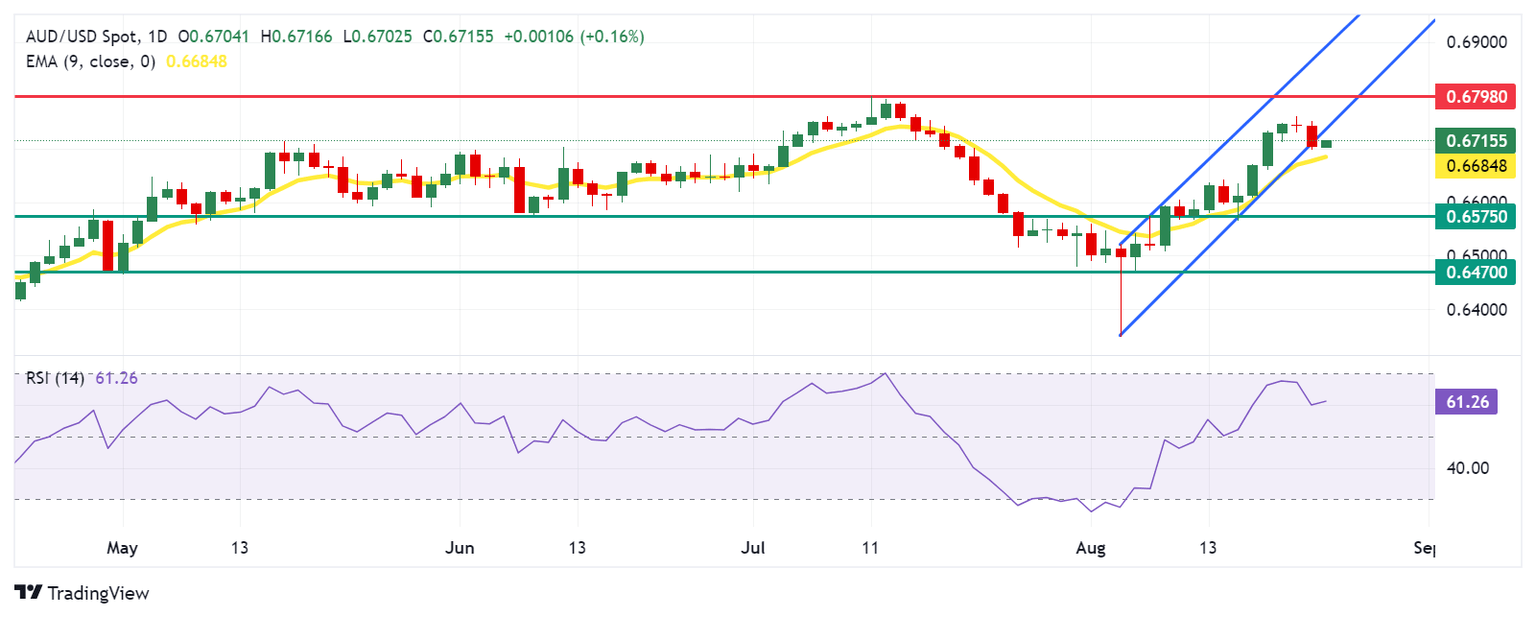Australian Dollar advances as US Dollar remains subdued ahead of Fed Powell's speech
- The Australian Dollar gains ground due to an improved risk-on mood on Friday.
- The AUD may appreciate further due to the hawkish sentiment surrounding the RBA’s stance on its policy outlook.
- The US Composite PMI indicated that business activity continues to grow, marking 19 consecutive months of expansion.

The Australian Dollar (AUD) retraces its recent gains against the US Dollar (USD) amid rising risk-on sentiment on Friday. Traders await the US Federal Reserve (Fed) Chair Jerome Powell’s speech at the Jackson Hole Symposium later in the North American session.
The AUD/USD pair could advance further due to the hawkish mood surrounding the Reserve Bank of Australia (RBA) about its policy outlook. RBA Governor Michele Bullock expressed that the Australian central bank will not hesitate to raise rates again to combat inflation if needed. Additionally, RBA's August Meeting Minutes suggested that the cash rate might stay unchanged for an extended period.
The US Dollar (USD) depreciates amid lower Treasury yields on Friday. However, the Greenback received support from the mixed S&P Global Purchasing Managers Index (PMI) data released on Thursday.
The US Composite PMI dipped slightly to 54.1 in August, a four-month low, down from 54.3 in July, yet remained above market expectations of 53.5. This suggests that US business activity continues to expand, marking 19 straight months of growth.
Daily Digest Market Movers: Australian Dollar appreciates due to improved risk sentiment
- CME FedWatch Tool suggests that the markets are now pricing in 73.5% odds of a 25 basis point (bps) Fed rate cut in its September meeting, up from 62.0% a day ago. The probability of a 50 basis point rate cut decreased to 26.5% from 38.0% a day earlier.
- The S&P Global US Services PMI inched up to 55.2 in August 2024, from 55.0 in July, defying expectations of a drop to 54.0. Meanwhile, the Manufacturing PMI declined to 48.0 in August from 49.6 the previous month, falling short of market expectations of 49.6 and signaling the second consecutive contraction in US factory activity at the sharpest rate this year.
- Australia's Judo Bank Composite Purchasing Managers Index (PMI) rose to 51.4 in August, up from 49.9 in July. This increase marks the fastest expansion in three months, driven by a stronger performance in the services sector, despite a more pronounced contraction in manufacturing production.
- On Thursday, Federal Reserve Bank of Boston President Susan Collins indicated that it will soon be appropriate to start cutting rates, emphasizing that the pace of these cuts will be guided by incoming data. Meanwhile, Kansas City Fed President Jeff Schmid mentioned that he is closely examining the factors behind the rise in the unemployment rate and will rely on data to determine whether to support a rate reduction next month.
- The Judo Bank Australia Services PMI climbed to 52.2 in August from 50.4 in July, marking the fastest expansion in services output in three months, according to preliminary data. Meanwhile, the Manufacturing PMI slightly increased to 48.7 from 47.5 reading, signaling a continued but slower decline in the sector's health for the seventh consecutive month.
- FOMC Minutes for July’s policy meeting indicated that most Fed officials agreed last month that they would likely cut their benchmark interest rate at the upcoming meeting in September as long as inflation continued to cool.
- On Tuesday, the RBA Minutes suggested that the board members had considered a rate hike earlier this month before ultimately deciding that maintaining current rates would better balance the risks. Additionally, RBA members agreed that a rate cut is unlikely soon.
Technical Analysis: Australian Dollar rebounds from 0.6700 to move back into the ascending channel
The Australian Dollar trades around 0.6710 on Friday. Daily chart analysis shows the AUD/USD pair has breached below the ascending channel, suggesting a weakening of a bullish bias. However, the 14-day Relative Strength Index (RSI) remains above the 50 mark, supporting the ongoing bullish momentum.
On the upside, the AUD/USD pair could test the upper boundary of the ascending channel at the 0.6740 level. A return to the ascending channel would reinforce the bullish bias and lead the pair to test the seven-month high of 0.6798. A break above this level could lead the pair to explore the region around the upper boundary of the ascending channel at the 0.6880 level.
For support, the AUD/USD pair may find support near the nine-day Exponential Moving Average (EMA) at the 0.6684 level. If it falls below this level, it could test the throwback level at 0.6575, followed by another throwback level at 0.6470.
AUD/USD: Daily Chart
Australian Dollar PRICE Today
The table below shows the percentage change of Australian Dollar (AUD) against listed major currencies today. Australian Dollar was the strongest against the US Dollar.
| USD | EUR | GBP | JPY | CAD | AUD | NZD | CHF | |
|---|---|---|---|---|---|---|---|---|
| USD | -0.12% | -0.16% | -0.47% | -0.14% | -0.25% | -0.46% | 0.21% | |
| EUR | 0.12% | -0.03% | -0.32% | -0.02% | -0.13% | -0.11% | 0.34% | |
| GBP | 0.16% | 0.03% | -0.31% | 0.00% | -0.10% | -0.05% | 0.11% | |
| JPY | 0.47% | 0.32% | 0.31% | 0.32% | 0.21% | 0.22% | 0.43% | |
| CAD | 0.14% | 0.02% | -0.01% | -0.32% | -0.11% | -0.07% | 0.10% | |
| AUD | 0.25% | 0.13% | 0.10% | -0.21% | 0.11% | 0.03% | 0.20% | |
| NZD | 0.46% | 0.11% | 0.05% | -0.22% | 0.07% | -0.03% | 0.17% | |
| CHF | -0.21% | -0.34% | -0.11% | -0.43% | -0.10% | -0.20% | -0.17% |
The heat map shows percentage changes of major currencies against each other. The base currency is picked from the left column, while the quote currency is picked from the top row. For example, if you pick the Australian Dollar from the left column and move along the horizontal line to the US Dollar, the percentage change displayed in the box will represent AUD (base)/USD (quote).
RBA FAQs
The Reserve Bank of Australia (RBA) sets interest rates and manages monetary policy for Australia. Decisions are made by a board of governors at 11 meetings a year and ad hoc emergency meetings as required. The RBA’s primary mandate is to maintain price stability, which means an inflation rate of 2-3%, but also “..to contribute to the stability of the currency, full employment, and the economic prosperity and welfare of the Australian people.” Its main tool for achieving this is by raising or lowering interest rates. Relatively high interest rates will strengthen the Australian Dollar (AUD) and vice versa. Other RBA tools include quantitative easing and tightening.
While inflation had always traditionally been thought of as a negative factor for currencies since it lowers the value of money in general, the opposite has actually been the case in modern times with the relaxation of cross-border capital controls. Moderately higher inflation now tends to lead central banks to put up their interest rates, which in turn has the effect of attracting more capital inflows from global investors seeking a lucrative place to keep their money. This increases demand for the local currency, which in the case of Australia is the Aussie Dollar.
Macroeconomic data gauges the health of an economy and can have an impact on the value of its currency. Investors prefer to invest their capital in economies that are safe and growing rather than precarious and shrinking. Greater capital inflows increase the aggregate demand and value of the domestic currency. Classic indicators, such as GDP, Manufacturing and Services PMIs, employment, and consumer sentiment surveys can influence AUD. A strong economy may encourage the Reserve Bank of Australia to put up interest rates, also supporting AUD.
Quantitative Easing (QE) is a tool used in extreme situations when lowering interest rates is not enough to restore the flow of credit in the economy. QE is the process by which the Reserve Bank of Australia (RBA) prints Australian Dollars (AUD) for the purpose of buying assets – usually government or corporate bonds – from financial institutions, thereby providing them with much-needed liquidity. QE usually results in a weaker AUD.
Quantitative tightening (QT) is the reverse of QE. It is undertaken after QE when an economic recovery is underway and inflation starts rising. Whilst in QE the Reserve Bank of Australia (RBA) purchases government and corporate bonds from financial institutions to provide them with liquidity, in QT the RBA stops buying more assets, and stops reinvesting the principal maturing on the bonds it already holds. It would be positive (or bullish) for the Australian Dollar.
Author

Akhtar Faruqui
FXStreet
Akhtar Faruqui is a Forex Analyst based in New Delhi, India. With a keen eye for market trends and a passion for dissecting complex financial dynamics, he is dedicated to delivering accurate and insightful Forex news and analysis.


















